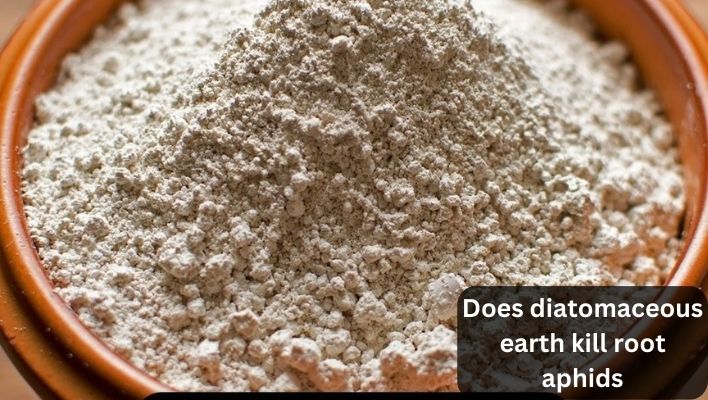Does diatomaceous earth really kill root aphids? If you’re a plant lover or gardener, you know how frustrating it can be to discover those pesky root aphids wreaking havoc on your precious plants. But nature has provided us with a remarkable solution – diatomaceous earth.
Diatomaceous earth has proven to be an effective pesticide dust but does diatomaceous earth really kill root aphids?” Well, prepare to be amazed by the power of this natural wonder.
Diatomaceous earth is a fine powder made from the fossilized remains of tiny aquatic organisms called diatoms. While it might seem harmless to the naked eye, it’s a formidable weapon against a wide range of pests, including root aphids. But how does it work? And is it truly effective?
In this article, we’ll explore the fascinating world of diatomaceous earth and its ability to combat root aphids. From understanding the nature of these pests to uncovering the secrets behind diatomaceous earth’s pest control prowess, we’ll delve into the topic and provide you with practical insights and tips for tackling root aphid infestations.
Get ready to discover an organic, safe, and powerful solution that could be the game-changer in your battle against root aphids. Let’s dive in and unveil the secrets of diatomaceous earth.
Root Aphids: The Silent Plant Destroyers
Root aphids, often referred to as “plant lice,” are minuscule insects that primarily infest the root systems of plants. These pests feed on the sap and vital nutrients, weakening the plant’s health and stunting its growth.
If left untreated, a root aphid infestation can lead to wilting, yellowing leaves, stunted development, and even the death of the plant.
Introducing Diatomaceous Earth
Diatomaceous earth is a remarkable substance that has gained popularity as a natural pest control solution. But what exactly is it, and how does it work? Let’s explore the ins and outs of diatomaceous earth and its applications in combating root aphids.
Diatomaceous earth is derived from the fossilized remains of diatoms, which are microscopic algae that lived millions of years ago in bodies of water. These diatoms had silica-based shells, and over time, their accumulated remains formed deposits known as diatomaceous earth. This earth is then mined, ground into a fine powder, and used for various purposes, including pest control.
The effectiveness of diatomaceous earth lies in its unique physical properties. Under a microscope, diatomaceous earth appears as a porous substance with countless tiny sharp edges. These edges are like minuscule glass shards, and when insects come into contact with diatomaceous earth, the powder adheres to their bodies.

As insects move across the diatomaceous earth-coated surface, the sharp edges of the powder scrape and abrade their protective waxy exoskeletons. This causes the insects to dehydrate and eventually perish. The abrasive action of diatomaceous earth on the exoskeleton disrupts the insect’s ability to retain moisture, leading to their demise.
There are different types of diatomaceous earth available on the market. The two main categories are food-grade and non-food-grade diatomaceous earth. Food-grade diatomaceous earth is considered safe for human consumption and is often used in grain storage to prevent infestations and pests. Non-food-grade diatomaceous earth is typically used for industrial purposes, such as filtration or pest control.
When it comes to controlling root aphids, it is crucial to use food-grade diatomaceous earth. This ensures that the product is free from harmful additives or contaminants that could pose a risk to plants or humans.
It is also important to note that while diatomaceous earth is generally safe for humans and animals, it can be abrasive to their respiratory systems if inhaled in excessive amounts. Therefore, proper precautions should be taken when handling and applying diatomaceous earth.
Will diatomaceous earth kill root aphids?
Now that we understand what diatomaceous earth is and how it works, let’s address the burning question: Will diatomaceous earth effectively kill root aphids? The answer is a resounding yes!
Numerous gardeners and farmers have attested to the effectiveness of diatomaceous earth in combating root aphids. Additionally, scientific studies have provided evidence supporting its use as a natural and safe solution for pest control.
One study published in the Journal of Economic Entomology found that diatomaceous earth significantly reduced the population of root aphids in greenhouse-grown plants. The researchers observed a decline in aphid numbers and noted that diatomaceous earth effectively disrupted the pests’ life cycle, impeding their ability to reproduce and infest new plants.
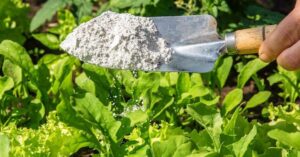
Another study published in the Journal of Economic Entomology evaluated the efficacy of diatomaceous earth against various pests, including aphids. The researchers concluded that diatomaceous earth effectively controlled aphid populations by causing dehydration and physical damage to their exoskeletons.
The abrasive action of diatomaceous earth, as discussed earlier, plays a vital role in controlling and eliminating root aphids. When applied to the soil or directly to affected plant roots, the powder creates a barrier that root aphids must come into contact with. As they crawl across the diatomaceous earth, the sharp edges lacerate their exoskeletons, leading to dehydration and ultimately their demise.
It is important to note that while diatomaceous earth is highly effective against root aphids, it works best when applied as part of an integrated pest management approach. This means combining diatomaceous earth with other preventive measures, such as maintaining healthy soil conditions, practicing proper watering techniques, and implementing good sanitation practices in your garden.
How to Use Diatomaceous Earth for Root Aphid Control
Now that we understand the effectiveness of diatomaceous earth against root aphids, let’s explore the step-by-step process of applying diatomaceous earth to treat root aphids.
The application methods may vary depending on the situation, such as potted plants, gardens, or hydroponics. Here’s a comprehensive guide:

Step 1: Prepare the diatomaceous earth
- Choose food-grade diatomaceous earth specifically labeled for pest control.
- Put on gloves and a dust mask to protect yourself from inhaling the fine powder.
- Stir the diatomaceous earth to loosen any clumps and make it easier to apply.
- Ensure the plants you’re treating are dry, as moisture can reduce the effectiveness of diatomaceous earth.
Step 2: Identify the infested plants and areas
- Inspect your plants for signs of root aphids, such as wilted leaves, yellowing foliage, or weak growth.
- Focus on areas where root aphids are commonly found, such as the base of the plant, soil surface, or hydroponic systems.
Step 3: Application for potted plants
- Gently remove the top layer of soil to expose the root system.
- Sprinkle a thin layer of diatomaceous earth around the base of the plant, covering the soil surface.
- Gently work the diatomaceous earth into the top layer of soil using a small trowel or your fingers.
- Be sure to cover the entire root zone, paying extra attention to areas with visible aphid activity.
Step 4: Application for gardens
- Sprinkle diatomaceous earth evenly over the soil surface around the infested plants.
- Use a handheld duster or a shaker container to distribute the diatomaceous earth more evenly.
- Lightly rake the soil to work the diatomaceous earth into the top layer.
- Reapply diatomaceous earth after rainfall or watering to maintain its effectiveness.
Step 5: Application for hydroponics
- Prepare a diluted solution of diatomaceous earth by mixing it with water according to the manufacturer’s instructions.
- Use a spray bottle or a fine-mist sprayer to apply the diluted solution directly to the roots of the affected plants.
- Ensure that the entire root system is thoroughly coated with the diatomaceous earth solution.
- Repeat the application as needed, depending on the severity of the infestation.
Step 6: Monitor and reapply as necessary
- Regularly monitor the plants for any signs of re-infestation or persistent aphid activity.
- If necessary, reapply diatomaceous earth following the same application methods outlined above.
- Continue to monitor and maintain the diatomaceous earth barrier to prevent future infestations.
Remember to always follow the safety guidelines and precautions provided by the manufacturer when handling and applying diatomaceous earth.
By properly applying diatomaceous earth, you can effectively control root aphids and protect the health and vitality of your plants.
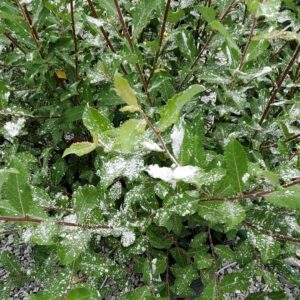
Safety guidelines and precaution
When using diatomaceous earth for root aphid control, it is crucial to prioritize safety by following the recommended guidelines and precautions.
Although diatomaceous earth is generally considered safe for humans, pets, and plants, it is essential to handle it responsibly to minimize any potential risks. Here’s why safety guidelines and precautions are important:
- Protecting yourself: Diatomaceous earth can be drying to the skin, so wearing gloves when handling it is advisable. Additionally, it is recommended to wear a mask or respirator to prevent inhaling excessive dust, especially during the application process.
- Preventing eye irritation: While applying diatomaceous earth, it’s essential to avoid contact with the eyes. In case of accidental contact, rinse the eyes thoroughly with clean water and seek medical attention if irritation persists.
- Inhalation precautions: Although diatomaceous earth is non-toxic, inhaling large amounts of dust may cause respiratory irritation. To minimize the risk, work in a well-ventilated area and avoid creating excessive dust during application. If respiratory discomfort occurs, move to an area with fresh air.
- Proper storage: Store diatomaceous earth in a cool, dry place away from moisture and direct sunlight. Ensure it is kept out of reach of children and pets.
Tips and Best Practices for Maximizing Effectiveness
To maximize the effectiveness of diatomaceous earth in controlling root aphids, consider the following tips and best practices:
- Early detection: Regularly monitor your plants for signs of root aphid infestation. Early detection allows for prompt action and better chances of successful eradication.
- Thorough application: When applying diatomaceous earth, ensure even coverage, particularly in areas where root aphids are active. Pay attention to the soil surface, the base of the plant, and areas around the root system.
- Regular inspection and maintenance: Continuously monitor your plants even after applying diatomaceous earth. Inspect for any signs of re-infestation or persistent aphid activity. If necessary, reapply diatomaceous earth to maintain its protective barrier.
- Consider holistic approaches: While diatomaceous earth is an effective natural remedy, combining it with other organic pest control methods can enhance its efficacy. For instance, beneficial insects or companion planting can help prevent and control root aphids.
- Follow the recommended application frequency: Refer to the manufacturer’s instructions for the recommended application frequency. Adhering to the guidelines ensures that diatomaceous earth remains effective in deterring and eliminating root aphids.
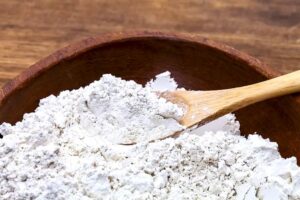
Other natural methods for controlling root aphids
While diatomaceous earth is a reliable option for controlling root aphids, there are several other natural methods worth considering.
Here, we briefly mention alternative approaches to root aphid control, discuss their advantages and limitations, and encourage a holistic approach to pest management.
- Horticultural oils: Horticultural oils, such as mineral oil or insecticidal soap, can suffocate and kill root aphids by coating their bodies. These oils are safe for plants and the most beneficial insects, making them a viable option for organic gardening. However, thorough coverage is essential for their effectiveness, and multiple applications may be necessary. These oils can be applied as a spray to the affected plants and roots, targeting the aphids directly. Horticultural oils are safe for plants when used as directed and can provide effective control when applied properly.
- Garlic spray: Garlic spray is a homemade remedy that can repel and deter root aphids. It works by emitting a strong odor that the aphids find unpleasant. While garlic spray is easy to make and environmentally friendly, it may not provide complete eradication of root aphids and is more suitable for mild infestations or preventive measures.
- Soil drenches: Soil drenches using natural solutions can be effective in controlling root aphids. Examples include drenching the soil with a solution made from neem oil, garlic extract, pyrethrin, or insecticidal extracts from plants like chrysanthemums can be effective in suppressing aphid populations. These solutions work by targeting the aphids in the soil, disrupting their life cycle, and reducing their population. It is important to follow the instructions and recommended concentrations for these natural solutions to avoid any negative effects on the plants.
- Companion planting: Certain plant species possess natural repellent properties against aphids. Companion planting involves strategically placing these repellent plants near susceptible plants to deter pests. For example, planting marigolds, chives, or garlic alongside susceptible plants can help repel root aphids. Companion planting offers a natural and visually appealing way to manage aphids but may not provide complete control on its own.
- Cultural practices: Implementing good cultural practices can help prevent and manage root aphid infestations. Practices such as proper watering techniques, avoiding over-fertilization, regular inspection and monitoring, and maintaining healthy soil conditions can strengthen plants and make them less susceptible to aphid attacks. Additionally, practicing crop rotation can disrupt the life cycle of root aphids and reduce the risk of recurring infestations.
- Biological control agents: Utilizing biological control agents is an eco-friendly and sustainable method for managing root aphids. Beneficial nematodes, such as Steinernema feltiae, are microscopic roundworms that parasitize and kill root aphids. They can be applied to the soil, where they actively seek out and attack aphid larvae and adults. Introducing nematodes into the affected areas can help suppress root aphid populations over time.
It is important to note that no single method may completely eliminate root aphids, and a combination of these natural approaches may yield the best results.
Consider your specific circumstances, the severity of the infestation, and the needs of your plants when choosing the most appropriate methods for controlling root aphids naturally.
Advantages and Limitations of Alternative Methods
Each alternative method for controlling root aphids has its own advantages and limitations:
- Advantages: These methods offer natural and eco-friendly approaches to pest control, reducing reliance on synthetic chemicals. They are safer for beneficial insects, promote biodiversity, and minimize potential harm to human health and the environment. They can also be integrated into a comprehensive pest management plan for long-term effectiveness.
- Limitations: Alternative methods may not provide immediate or complete eradication of root aphids, especially in severe infestations. Their effectiveness can vary depending on factors such as the aphid species, environmental conditions, and proper application. Regular monitoring and proactive measures are essential for successful control.
Encouraging a Holistic Approach to Pest Management
To effectively manage root aphids and other pests, it is crucial to adopt a holistic approach to pest management. This approach involves combining various control methods, such as cultural practices (maintaining plant health, proper watering, and pruning), biological control (introducing beneficial insects), physical barriers (like diatomaceous earth), and regular monitoring.
By incorporating diverse strategies, you create a resilient and balanced ecosystem that is less prone to pest infestations. Additionally, practicing good plant hygiene, promoting soil health, and rotating crops can help prevent and mitigate root aphid problems.
Remember, no single method is foolproof, and it is often the combination of different approaches that leads to successful and sustainable pest control.
In conclusion, exploring alternative methods, understanding their advantages and limitations, and implementing a holistic pest management approach will empower you to effectively control root aphids while promoting a healthy and thriving garden or crop environment.
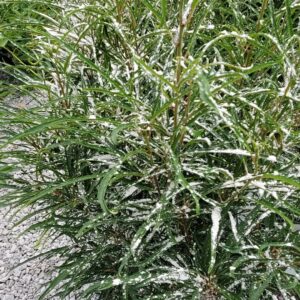
Does diatomaceous earth kill root aphids FAQs
Can diatomaceous earth harm beneficial insects or plants?
When used properly, diatomaceous earth is generally safe for beneficial insects and plants. Its mode of action primarily targets pests with exoskeletons, such as aphids, root aphids, and mealybugs, by physically damaging their protective layers.
However, it is always important to apply diatomaceous earth directly to the affected areas and avoid excessive use, especially on flowers where beneficial insects might be present.
By targeting the soil surface or specific areas of infestation, you can minimize the contact between beneficial insects and diatomaceous earth, reducing any potential harm.
How long does it take for diatomaceous earth to kill root aphids?
The exact time it takes for diatomaceous earth to eliminate root aphids can vary depending on factors such as the severity of the infestation, environmental conditions, and the effectiveness of the application.
While diatomaceous earth can begin to affect root aphids upon contact, it may take a few days to several weeks to achieve noticeable results.
Root aphids in direct contact with the diatomaceous earth will begin to experience damage and dehydration, leading to their eventual demise. Continuous monitoring and reapplication may be necessary to ensure long-term control.
Can diatomaceous earth be used indoors?
Yes, diatomaceous earth can be used indoors for controlling root aphids. However, it is important to exercise caution during indoor applications to minimize dust and ensure proper ventilation.
Use food-grade diatomaceous earth, which is safe for humans and pets, and follow the application guidelines provided by the manufacturer. It is recommended to focus on the soil or growing media of indoor plants, avoiding excessive dusting on foliage.
Additionally, consider placing a protective barrier, such as a tray or saucer, under potted plants to prevent the diatomaceous earth from spreading to unintended areas.
Is diatomaceous earth effective against other pests?
Yes, diatomaceous earth is effective against a wide range of pests, including crawling insects such as ants, fleas, and cockroaches. Its abrasive nature and ability to damage the exoskeletons of pests make it an efficient natural pesticide.
However, the effectiveness of diatomaceous earth may vary depending on the specific pest species and their susceptibility to physical abrasion.
It is always recommended to conduct research or consult with pest control professionals to determine the suitability and efficacy of diatomaceous earth for specific pest problems.
Conclusion
Diatomaceous earth offers a natural and effective solution for controlling root aphids. With its unique physical properties and ability to damage the exoskeletons of pests, diatomaceous earth can help eliminate root aphids and prevent further infestations.
Scientific studies and anecdotal evidence support its efficacy, making it a trusted option for gardeners and farmers seeking environmentally friendly pest control methods.
When using diatomaceous earth, it is important to follow safety guidelines and precautions to ensure proper handling and application. Wearing protective gear, avoiding windy conditions, and storing it correctly is crucial for safe usage.
In addition to diatomaceous earth, other proven natural methods, such as beneficial insects, horticultural oils, companion planting, soil drenches, and cultural practices, can also contribute to effective root aphid control.
By incorporating diatomaceous earth into your pest management strategy and combining it with other natural approaches, you can maintain healthy plants, protect beneficial insects, and enjoy the benefits of a thriving garden or indoor plant environment.
